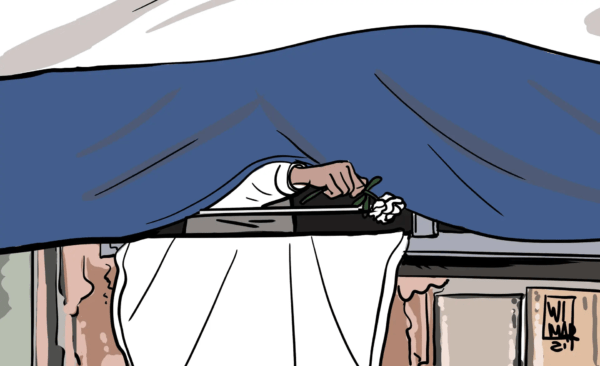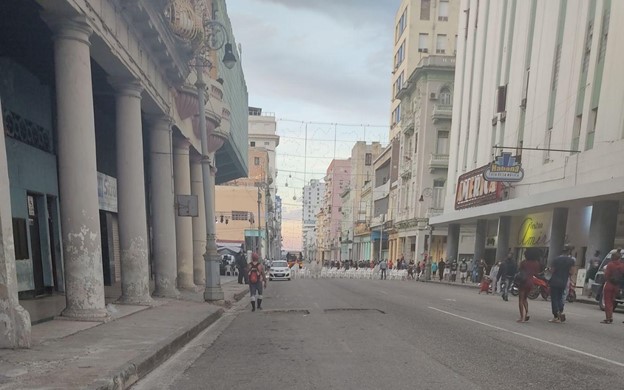Silenced Cries on 15N in Cuba

HAVANA TIMES – What happened in Cuba on November 15th? The question continues to be mulled over, days later. Though the final result was a contradiction. Looking at photos that show violent acts of repression by pro-government civilians against dissidents, we can see that November 15th didn’t end up being that calm Monday pro-government political forces wanted. It was already “15N” before the day rolled around, a term which Archipielago had coined, the opposition group that called for a civil protest to report police violence and to demand the release of political prisoners, among other things.
Today, the group is going through a time of uncertainty with news that its leader, whose disappearance had been reported, arrived in Spain on Wednesday, along with his wife Dayana Prieto. “We are alive, healthy and with our ideas intact,” Garcia Aguilera posted on Facebook. However, the story of a day that joins other decisive days in the history of this movement (look at the chronology) began a long time before.
In September, Archipielago requested authorization to peacefully protest in favor of these humanitarian causes. This request for authorization, which was made publicly and through official channels, became an unprecedented event.
The Government not only denied authorization, but it also stepped up its slander campaign that it had already begun against members of the initiative, as well as calling the protest “illegal”. As a way of diverting attention away from 15N, the Government announced that the academic year would begin on this day.

They sought to prevent reedition of the July 11th protests by any means, when thousands of Cubans took to the streets in Havana and in other cities to demand freedom and better living conditions, beginning with healthcare. Over this day, security forces arrested protestors, with the help of civilians. Over 600 of them are still in jail. Meanwhile, journalists, activists and other civil society actors have been summoned for interrogation and have been harassed quite frequently after Archipielago made its public request.
As a result, it’s no surprise that independent journalists, Archipielago members and dissident activists woke up under police surveillance, house arrest and suffered other acts of harassment on the 15th, which in some cases had already been reported since the 13th and 14th. Neighbors, pro-government groups or plainclothes police offers surrounded their homes so they were unable to leave. They even carried out hate rallies, when groups of people seek to intimidate and reduce opposition members and their families with shouting, slogans and threats.
An unusual presence of law enforcement agencies, in uniform and dressed as civilians, was also reported in some Cuban cities. Meanwhile, pro-government groups held activities in different points where the protest could gather force. There were also police operations at homes of artists, activists and independent journalists to stop them from going outside. On Havana’s central Galiano Street, passers-by were cut off from walking down it, to stop it from becoming a focal point for mobilization similar to that on July 11th. Some activists who managed to leave their homes were immediately arrested, such as Rafael Santos and Agustin Figueroa in Havana.
The day before, on the 14th, playwright Yunior Garcia, the most visible face of Archipielago and the 15N call for protest, was forced to stay locked up in his house, as he was the subject of a prolonged hate rally. Harassed by a large group of people and police officers, Garcia calmly appeared in a livestream in which he said that he would go outside in spite of being sure that he would be arrested. However, he was later caught by the international press while he showed a white rose with a sign that read “My house is being blockaded.” Government agents covered a part the apartment building with large Cuban flags.
“I believe that we are living really ugly days (…) Nobody can be the owner of a country that belongs to every one of its citizens,” Yunior had said in a livestream on Facebook.
Other cases of harassment and persecution happened in Santa Clara on this same day at Saily Gonzalez’s home; one of the coordinators of Archipielago, who woke up surrounded by a group of women who shouted out slogans and verbally attacked her. On the other side of the street, Cuban flags, flags of the Young Communist League and the Federation of Cuban Women were hung, while participants carried signs with phrases supporting the Government.

Meanwhile, Miryorly Garcia, another one of Archipielago’s coordinators, and Raul Gonzalez, coordinator of the Citizen Consensus Movement, reported hate crimes against them. Miryorly Garcia said that the majority of her neighbors didn’t join in and some gave her signs of support from their homes. “Thanks to those who say no, to those who have bravely and publicly recognized my values and have not joined in on the defamation and scorn,” she wrote on her Facebook page.
The Archbishopric of Camaguey, where the Archbishop Monsignor Wilfredo Pino and priest Alberto Reyes were, was also surrounded by pro-government groups who shouted out slogans in chorus. Reyes – who signed the authorization request for a protest in Camaguey – was one of the clerics threatened by the Communist Party’s Office of Religious Affairs of going to jail if he protested on November 15th.
The family of Andy Garcia Lorenzo, who has been detained ever since the 11J protests, were also victims of a similar act. His family had hung up a sign asking for the young man’s release, while the Public Prosecutor’s Office is asking for seven-year prison sentence. Meanwhile, art historian and activist Carolina Barrero was arrested as she left her house and released in the afternoon on the 16th.
According to reports from the Justicia 11J group, 55 arbitrary arrests were made on political grounds between November 3rd and the 15th, most of which were recorded between the 13th and 15th. On its Facebook page, Justicia 11J says that at least 27 people were temporarily arrested on 15N. While the Center of Legal Information CUBALEX documented 168 incidents of politically-motivated harassment.
“The regime has masterfully shown that it’s a tyranny, that it doesn’t even respect its own legal mechanisms for citizens to criticize what they deem to worthy of criticism, and to protest against what is condemnable,” David Martinez from Archipielago told elTOQUE.
Martinez added that the “wave of terror unleashed via arrests, harassment, warning letters, threats with long prison sentences, etc, has marked the standard in the lead-up to 15N.” According to lawyer Eloy Vieira, the Government proved that there is no legal or political solution to any problem, “that they only resort to violence and repression.”
There are many different and extreme interpretations about 15N, from considering it a success to classifying it as a failure. That said, with Yunior Garcia leaving Cuba and prolonging the Civic actions to November 27th, by Archipielago, there are new challenges: Not only for this unprecedented movement on the island, but for the Government itself, and its attempts to silence the voices of those who dissent and demand real change sooner than later.
——–
This article was written in collaboration with CONNECTAS.






Barbarians ? Terror ? I guess, under somebody’s definition. In my country though, protestors can get rougher treatment than a couple people showing up a their door for an hour yelling insults. In my country, which has all kinds of sanctions against Cuba for allegedly for human rights abuses, you can go out with your AR15, and chum it up with the police, and shoot yourself 3 or 4 leftists, or “antifa” or BLMers, and get off lighter than someone with a parking ticket. Just don’t try the same thing if you are Black or Muslim, environmentalist or leftist though.
Communist barbarians and their wave of terror. A failed unelected system.